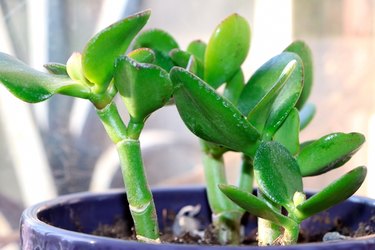
The classic jade plant (Crassula ovata, USDA zones 11-12) and its close cousin, the Chinese pine jade (Crassula tetragona, zones 10-11), native to South Africa, are two jade species that can be trimmed into bonsai. Hardy in sheltered and frost-free areas, they are easy to grow and can be kept indoors or outdoors. In areas outside their hardiness limits, they're easily grown as houseplants.
The root systems of jade plants lend themselves to shallow containers, which makes them ideal choices to use as bonsai, or miniature plants. To bonsai a jade plant is fairly simple—the thick branches can be manipulated with ease using weights and wire. With care and attention, a jade plant can make an attractive bonsai.
Video of the Day
Video of the Day
Things You'll Need
How to Bonsai a Jade Plant
Step 1: Put on Safety Gear
Put on safety goggles and gloves before working with potting mixes, sterilizing soluti
ons and cutting tools. The sap of jade plants generally doesn't cause skin reactions, but protect your eyes and skin from the other elements used in preparing and pruning the plant.
Step 2: Sterilize Your Cutting Tools
Sterilize the blades of your cutting tools by dipping them in rubbing alcohol or a household cleaner like Lysol. Avoid chlorine bleach as it corrodes and pits the metal blades. Alternatively, dip a rag in the sterilizing solution and wipe the blades between cuts.
Step 3: Select a Bonsai Container
Traditional bonsai pots or pans are shallow to accommodate plants that are root-pruned, a practice that helps the developing plant achieve the "bonsai look," which is a miniature version of the mature specimen. If you've purchased a jade plant in a deeper container than your bonsai pot or pan, prune the roots (if necessary) and flare them out laterally to seat the plant in its container. Use a cactus potting mix or 1 part sterilized loam, 2 parts sharp sand and 2 parts peat.
Step 4: Choose a Shape
You can train your jade bonsai into many of the traditional bonsai styles, such as "leaning" (which has a slanted, windswept look) or "informal upright" (in which the trunk bends to the left or the right). The thick trunk and fleshy rounded leaves of the classic jade plant and the pine tree-shaped leaves of the Chinese pine jade are all suited to traditional bonsai forms.
Step 5: Repot the Jade Plant
Prepare the jade plant for its new container. When repotting, trim back the roots a bit by 1/4 inch or so. Once established in the container, repot the jade bonsai plant every couple of years in spring or summer. Give the plant a break from watering for a few weeks after repotting before resuming a regular watering schedule.
Step 6: Shape the Jade Plant
Pinch and remove branches that are growing in undesired places to refine your jade bonsai to fit the design. Cut the branches with sharp, sterilized pruners, flush with but not cutting into the thick "trunk" of the jade plant. Take care not to cut too deeply or it may cause a scar. Jade plants are tough and do not require sealing after pruning.
Step 7: Manipulate the Branches
Manipulate your bonsai with gentle wiring. Wrap aluminum wire around the branch and then bend the branch into the desired shape. Use 1-millimeter wire for smaller trees and continue to move up in size as the tree grows to support and shape the branches. Wiring the tree is best done in the fall or winter.
Step 8: Maintain the Bonsai Form
Maintain the bonsai form by trimming it to train its shape. Because jade plants are slow growers, they'll need pinching back or pruning only once or twice during the growing season.
Step 9: Fertilize to Support the Plant
Fertilize once or twice a month during the growing season of spring and summer. Do not fertilize during the winter months. Use a balanced fertilizer formulated for succulents. Always water after fertilizing.
Step 10: Water, But Don't Overwater
Water the jade bonsai enough to keep the plant from drying out. Take care not to overwater it (do not allow the soil to become soggy). Allow the top of the soil to dry out a bit between waterings; then add just enough water to moisten the soil. Reduce watering during the winter months.